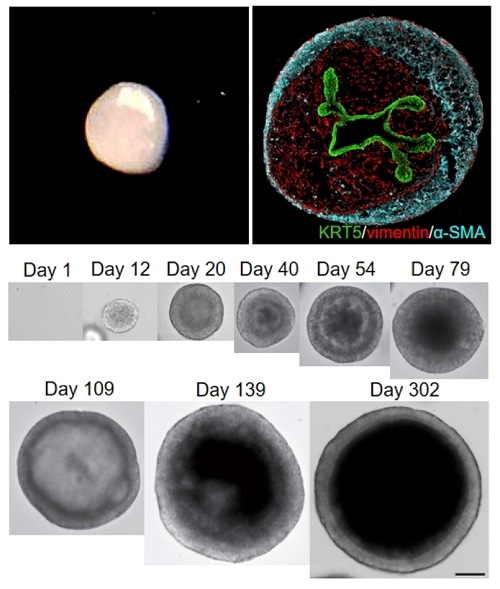Organoids are tissues that look like organs and are extracted from stem cells cultured in laboratories. They are usually known as miniature organs.

A bladder assembloid, a reconstituted organoid with three tissue layers of the human bladder. Image Credit: Kunyoo Shin (Pohang University of Science and Technology).
Since organoids can mimic the function and structure of human organs, they are regarded as the state-of-the-art technology for developing novel drugs or producing artificial organs.
In the recent past, a Korean-based research team has introduced a novel idea of mini-organs known as assembloid that exceeds such organoids to functionally and structurally summarize human tissues. The findings were published in the Nature journal—one of the leading journals in science and technology—on December 17th, 2020 (KST).
Headed by Professor Kunyoo Shin from the Department of Life Sciences at Pohang University of Science and Technology (POSTECH), a research team has designed assembloids—that is, multi-layered miniature organs—that accurately imitate human tissues by reconstituting the stem cells in 3D, along with numerous types of cells found in tissue stroma.
Assembloid—the latest, groundbreaking technology—can serve as a new model for the revolutionary drug discovery of intractable disorders as patient-tailored human organs that outpace the traditional organoids.
Organoids are essentially small organs that are analogous to human organs. But one fundamental limitation in the present-day organoid technology is that it cannot imitate the mature organ structure and does not have the microenvironment needed inside the tissues.
Moreover, no crucial interactions occur between numerous cells inside the human tissues. Such a limitation has been regarded as a significant problem in accurately modeling numerous intractable medical conditions, such as cancer.
Hence, to resolve these drawbacks, Shin’s research group has designed reconstituted in-vitro human organs known as assembloids. These assembloids have organized structures of stromal layers, epithelial cells, and outer muscle cells.
The investigators observed that these assembloids and the mature adult organs were both identical in terms of gene expression and cell composition at the single cellular level and that they also imitate the in-vivo regenerative reaction of normal tissues to any kind of injury.
The researchers also designed patient-specific tumor assembloids that ideally imitate the pathological features of in vivo tumors. They used this tumor assembloid platform with genetic engineering technologies and eventually demonstrated the new mechanisms, wherein the signals from the tumor microenvironment establish the plasticity of the cancer cells.
These results demonstrate that the signaling feedback between the stromal and cancer cells has a crucial role to play in regulating the plasticity of the tumor. A discovery like this will result in an innovative model in the development of cell differentiation therapy for treating numerous types of aggressive solid cancers.
These assembloids are the world’s first in-vitro reconstituted organoids.”
Eunjee Kim, Study First Author, Department of Life Sciences, Pohang University of Science and Technology
Kim continued, “We can precisely model a variety of complex intractable diseases such as cancer, degenerative diseases, and various neurological diseases including schizophrenia and autism, and understand the pathogenesis of such diseases to ultimately develop better therapeutic options.”
To our knowledge, our efforts to generate assembloids that structurally and functionally recapitulate the pathophysiology of original tissues have not been previously described.”
Kunyoo Shin, Study Lead and Professor, Department of Life Sciences, Pohang University of Science and Technology
Professor Shin continued, “Generating such artificial tissues is particularly relevant to modern research because the importance of tissue microenvironments in epithelial tissue homeostasis and the growth of various tumors is increasingly being recognized. We anticipate our study to open a new era of a drug discovery that will revolutionize the advancement of patient-customized treatment for various intractable diseases.”
This study is a great model for interdisciplinary science, and presents a new direction for precise and personalized therapy for various human diseases.”
Tae-Young Roh, Professor, Pohang University of Science and Technology
Professor Roh was also involved in the study.
Source:
Journal reference:
Kim, E., et al. (2020) Creation of bladder assembloids mimicking tissue regeneration and cancer. Nature. doi.org/10.1038/s41586-020-3034-x.